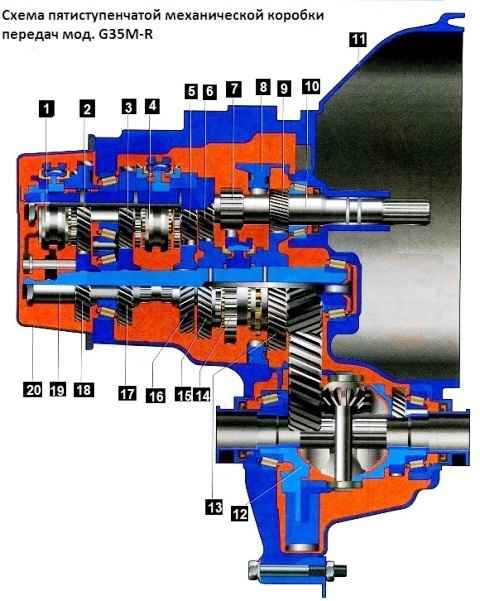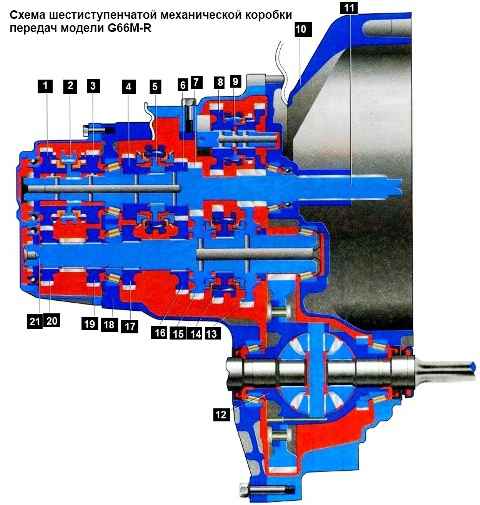For Mazda 6 cars, in the basic configuration (depending on the type of engine used) a manual gearbox mod. G35M-R or G66M-R
Manual gearboxes differ in gear ratios and the design of individual parts, but they have a fundamentally common layout (the six-speed G66M-R has differences in layout due to the presence of VI gear) and installation dimensions
On request, cars with a 2.0 liter petrol engine can be equipped with a five-speed automatic transmission mod. FS5A-EL, the installation dimensions of which are similar to those of mechanical boxes.
G35M-R and G66M-R manual gearboxes are removed and installed in almost the same way.

Manual transmission mod. G35M-R (Fig. 1) or G66M-R (Fig. 2) is made according to a two-shaft scheme, with synchronized forward gears.

The gearbox and final drive with differential share a common crankcase
Clutch housing attached to front of gearbox housing
A stamped steel cover is mounted on the rear of the gearbox housing.
Forward gears are switched on by axial movement of the synchronizer clutches mounted on the shafts
The gearshift mechanism is located inside the gearbox housing on its left side
There are two gear levers on the outside: the gear selector lever and the shift lever.
The control drive of a manual transmission consists of a gear shift lever with a ball joint mounted on the base of the body, two shift and gear selection cables, as well as a mechanism installed in the gearbox housing
In order to ensure precise gear shifting, the shift lever of the shift mechanism is one-piece with a massive counterweight.
The shift and select cables are structurally different from each other and are not interchangeable.
The main gear is made in the form of a pair of spur gears matched by noise
Torque is transmitted from the driven gear of the final drive to the differential and then to the front wheel drives.
Bevel differential, two-satellite
The tightness of the connection of the internal hinges of the front wheel drives with the differential gears is ensured by oil seals.
Possible malfunctions of a manual transmission and solutions
Vibration and noise in the gearbox
- loosening or damage to the engine and gearbox mounts
Tighten fasteners or replace supports
- wear or damage to gears and bearings
Repair the gearbox
- the wrong brand of oil was filled in
Fill with the correct brand of oil
- insufficient oil level
Top up the oil to the correct level
- Violation of engine idle adjustment
Adjust engine idle
Difficult shifting and grinding noise when shifting
- malfunction of the gearshift cables
Replace shift cables
- the wrong brand of oil was filled in
Fill with the correct brand of oil
- loose fit or wear of blocking rings and synchronizer cones
Repair the gearbox
- weakening of the synchronizer springs
Repair the gearbox
- incomplete engagement of the clutch
Repair the clutch release actuator and bleed the clutch system
Spontaneous disengagement
- wear of the shift forks or breakage of the springs of the clamps
Repair the gearbox
- increased clearance of the synchronizer clutch on the hub
Repair the gearbox
Oil leak
- destruction or damage to oil seals or o-rings
Replace seals or O-rings





